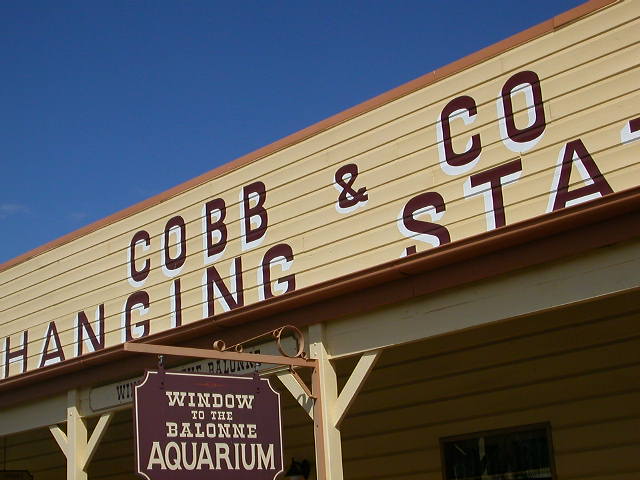
 |
| ROMA :: QUEENSLAND :: 29.4 S 149.8 ESteeped in colourful history, ROMA, 261km WEST OF DALBY, CLAIMS MANY FIRSTS: the first gazetted settlement after Queensland separated from NSW in 1859; the stateEs first wine-making venture in 1863; the first natural gas strike in Australia in 1900. Although sheep and cattle are major resources of this area, natural gas is still piped the 480km to Brisbane. A brief rush for oil was short-lived and the area is now dotted with abandoned rigs. The Big Rig at the entrance to the town stands as a memorial to Roma's romance with oil, while they are still making wine for visitors' tasting pleasure at the Romavilla Winery. Bushranger Harry Redford (Captain Starlight) was tried here and cleared of cattle rustling. Redford later masterminded the theft of 1000 head which were driven to South Australian saleyards - an epic drive that partly-inspired Thomas Alexander Browne's (Rolf Boldrewood) novel, Robbery Under Arms, which was subsequently made into two feature films. Roma sits at the junction of the Warrego and Carnarvon highways - strike south on the Carnarvon Highway and you are on your way to St George while the road north passes through Injune on the way to the spectacular Carnarvon Gorge. ROMA, 140km west of Miles, was founded by settlers eager to occupy country made available by the opening up of the Darling Downs in 1862. Once considered for a fantasy rail junction to link the east coast with the Gulf of Carpentaria, the town thrives on farming, supplemented by the oil and gas fields which have been exploited intermittently since the 1900s. There's not much for visitors to do here, but Roma is a useful place to stock up before heading north to Carnarvon National Park. Roma is a typical inland town: tidy, with streets lined with bottle trees (not only bottle-shaped but also full of sugary water for emergency stock-watering), and a slightly dated air lent by the iron decorations and wrapround balconies of its hotels. It also has a reputation for cattle markets - one day-long event saw over $1.6 million change hands; and every Easter there is a rodeo and carnival . Romavilla Winery has been producing prize-winning wine since 1863 - if you want to buy, it's about a kilometre north of town on the Carnarvon Road, at Quintin Street (Mon-Fri 8am-5pm, Sat 9am-noon & 2-4pm; tel 07/4622 1822). For history buffs, Roma was also the venue for the 1871 trial of the audacious Captain Starlight (also known as Harry Redford), who stole a thousand head of cattle off a nearby property and drove them down through the South Australian deserts to Adelaide for sale. An unusual white bull in the herd was recognized and Redford arrested, but his pioneering of a new stock route won such popular approval that the judge refused to convict him. The Warrego Highway runs through Roma as Bowen Street, and it's here on the eastern side of town you're greeted by the Big Rig , a drilling tower left as a monument to the oil boom of the 1920s, and beside it the information centre (daily 9am-5pm; tel 07/4622 4355). A landscaped bend in the river behind makes a good picnic spot if you just want a rest; for supplies, most of the town's shops, banks and businesses are one block north of Bowen on parallel McDowall Street . Roma's accommodation choices include Motel Carnarvon , 18 Northern Rd (tel 07/4622 1599 or free call 1800 621 155; $50-70), and the Starlight Motor Inn (tel 07/4622 2666; $70-90), which both offer standard motel beds; the Big Rig Caravan Park , 4 McDowell St (tel 07/4622 2538), near the Big Rig, has welcome hot showers available during sub-zero winter nights. Restaurants in Roma are fairly basic, though Deano's , at 77 Quintin St, does good steaks. The train station is one block south of the highway on Station Street at the corner of Charles Street (tel 07/4622 9411), and the bus terminal is on Bowen Street by the BP roadhouse near the Big Rig. The airport is a small strip a few kilometres outside town. Tickets for all these can also be obtained from Maranoa Travel, 71 Arthur St (tel 07/4622 1416). Heading north, the Carnarvon Developmental Road (take Quintin St from the town centre) gives access to Carnarvon National Park; otherwise the next stops west along the highway are Mitchell and Charleville. SURAT :: 27  THE first thing which struck me on a recent pass-through of Surat, a town of 500 souls south of Roma, was the town's strange, Asian-sounding name. In fact, Surat was indeed named after a British colonial residence in Madras, India, during the height of the British Empire. As in Madras, the legacy of the British Empire lives on in Surat, Queensland -- in an artfully preserved form. The town used to lie in an important transportation route during the colonial days, when Australians still dreamed of building a Utopia in the bush. The dream failed, the boom times ended, and Surat fell off the map. However, the town has managed to retain a sense of its faded glory, and is well worth visiting if you are on the way to Roma or Carnarvon Gorge. It is also an exceptionally clean and orderly town, a fact reflected in its numerous "Tidy Town" awards. According to a leaflet put out by its local council, Surat "had its beginnings in 1846 when Sir Thomas Mitchell explored this area. Upon his return to Sydney he dispatched Surveyor Burrowes
bathurst - Carnarvon Gorge - Kiama - Moree - Roma - Woolgoolga - - Wollongong
|
| |||||||||